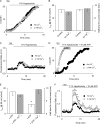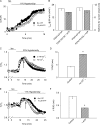P2X4 activation modulates volume-sensitive outwardly rectifying chloride channels in rat hepatoma cells
- PMID: 20056605
- PMCID: PMC2844204
- DOI: 10.1074/jbc.M109.063693
P2X4 activation modulates volume-sensitive outwardly rectifying chloride channels in rat hepatoma cells
Abstract
Volume-sensitive outwardly rectifying (VSOR) Cl(-) channels are critical for the regulatory volume decrease (RVD) response triggered upon cell swelling. Recent evidence indicates that H(2)O(2) plays an essential role in the activation of these channels and that H(2)O(2) per se activates the channels under isotonic isovolumic conditions. However, a significant difference in the time course for current onset between H(2)O(2)-induced and hypotonicity-mediated VSOR Cl(-) activation is observed. In several cell types, cell swelling induced by hypotonic challenges triggers the release of ATP to the extracellular medium, which in turn, activates purinergic receptors and modulates cell volume regulation. In this study, we have addressed the effect of purinergic receptor activation on H(2)O(2)-induced and hypotonicity-mediated VSOR Cl(-) current activation. Here we show that rat hepatoma cells (HTC) exposed to a 33% hypotonic solution responded by rapidly activating VSOR Cl(-) current and releasing ATP to the extracellular medium. In contrast, cells exposed to 200 microm H(2)O(2) VSOR Cl(-) current onset was significantly slower, and ATP release was not detected. In cells exposed to either 11% hypotonicity or 200 microm H(2)O(2), exogenous addition of ATP in the presence of extracellular Ca(2+) resulted in a decrease in the half-time for VSOR Cl(-) current onset. Conversely, in cells that overexpress a dominant-negative mutant of the ionotropic receptor P2X4 challenged with a 33% hypotonic solution, the half-time for VSOR Cl(-) current onset was significantly slowed down. Our results indicate that, at high hypotonic imbalances, swelling-induced ATP release activates the purinergic receptor P2X4, which in turn modulates the time course of VSOR Cl(-) current onset in a extracellular Ca(2+)-dependent manner.
Figures






Similar articles
-
Ca2+ nanodomain-mediated component of swelling-induced volume-sensitive outwardly rectifying anion current triggered by autocrine action of ATP in mouse astrocytes.Cell Physiol Biochem. 2011;28(6):1181-90. doi: 10.1159/000335867. Epub 2011 Dec 16. Cell Physiol Biochem. 2011. PMID: 22179006
-
Activation of H2O2-induced VSOR Cl- currents in HTC cells require phospholipase Cgamma1 phosphorylation and Ca2+ mobilisation.Cell Physiol Biochem. 2007;20(6):773-80. doi: 10.1159/000110437. Cell Physiol Biochem. 2007. PMID: 17982259
-
Swelling-induced, CFTR-independent ATP release from a human epithelial cell line: lack of correlation with volume-sensitive cl(-) channels.J Gen Physiol. 1999 Oct;114(4):525-33. doi: 10.1085/jgp.114.4.525. J Gen Physiol. 1999. PMID: 10498671 Free PMC article.
-
Receptor-mediated control of regulatory volume decrease (RVD) and apoptotic volume decrease (AVD).J Physiol. 2001 Apr 1;532(Pt 1):3-16. doi: 10.1111/j.1469-7793.2001.0003g.x. J Physiol. 2001. PMID: 11283221 Free PMC article. Review.
-
Hypotonicity and ethanol modulate BK channel activity and chloride currents in GH4/C1 pituitary tumour cells.Acta Physiol (Oxf). 2006 May-Jun;187(1-2):51-9. doi: 10.1111/j.1748-1716.2006.01544.x. Acta Physiol (Oxf). 2006. PMID: 16734742 Review.
Cited by
-
Cisplatin activates volume-sensitive like chloride channels via purinergic receptor pathways in nasopharyngeal carcinoma cells.J Membr Biol. 2015 Feb;248(1):19-29. doi: 10.1007/s00232-014-9724-2. Epub 2014 Sep 19. J Membr Biol. 2015. PMID: 25236172
-
Cell Death Induction and Protection by Activation of Ubiquitously Expressed Anion/Cation Channels. Part 1: Roles of VSOR/VRAC in Cell Volume Regulation, Release of Double-Edged Signals and Apoptotic/Necrotic Cell Death.Front Cell Dev Biol. 2021 Jan 12;8:614040. doi: 10.3389/fcell.2020.614040. eCollection 2020. Front Cell Dev Biol. 2021. PMID: 33511120 Free PMC article. Review.
-
Ion channels in regulated cell death.Cell Mol Life Sci. 2016 Jun;73(11-12):2387-403. doi: 10.1007/s00018-016-2208-z. Epub 2016 Apr 18. Cell Mol Life Sci. 2016. PMID: 27091155 Free PMC article. Review.
-
Purinergic signalling in liver diseases: Pathological functions and therapeutic opportunities.JHEP Rep. 2020 Jul 30;2(6):100165. doi: 10.1016/j.jhepr.2020.100165. eCollection 2020 Dec. JHEP Rep. 2020. PMID: 33103092 Free PMC article. Review.
-
Modulation of P2X4/P2X7/Pannexin-1 sensitivity to extracellular ATP via Ivermectin induces a non-apoptotic and inflammatory form of cancer cell death.Sci Rep. 2015 Nov 10;5:16222. doi: 10.1038/srep16222. Sci Rep. 2015. PMID: 26552848 Free PMC article.
References
-
- Hoffmann E. K. (2000) Cell Physiol. Biochem. 10, 273–288 - PubMed
Publication types
MeSH terms
Substances
LinkOut - more resources
Full Text Sources
Miscellaneous

